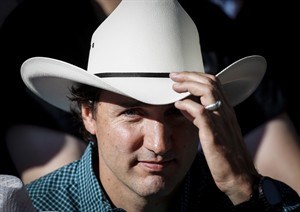
Liberal leader Justin Trudeau attends the Calgary Stampede parade, Friday, July 4, 2014. If you thought you've seen that snippet of "in over his head" Liberal Leader Justin Trudeau stripping off his shirt a zillion times, just wait ??? the political advertising season is about to explode. THE CANADIAN PRESS/Jeff McIntosh
July 10, 2014 - 2:38 PM
OTTAWA - If you thought you've seen that snippet of "in over his head" Liberal Leader Justin Trudeau stripping off his shirt a zillion times, just wait — the political advertising season is about to explode.
After a relative calm, Canadians are about to be doused with messaging as the parties try to influence voting intentions before the writ is dropped sometime in 2015.
A look at the Conservative Party of Canada's financial filings with Elections Canada paints a picture of what's in store: In 2012, the party spent just under a million in TV ads, and then $1.2 million last year.
Compare that to their television advertising buy in election year 2011 of a whopping $13.7 million dollars and you'll get a picture of just what's coming down the pike. A federal election must be held in 2015, but because there are legal limits to how much can be spent during the campaign, a sizable chunk will be blown beforehand.
"It is a fact that money facilitates political discourse and that paid political advertising is the only way for parties to communicate with citizens en masse, without the filter of the mainstream media," Conservative Fund chairman Irving Gerstein told a party convention last November of pre-election spending.
The NDP pointed to the looming advertising boom in a message to supporters this week. The Liberals spent $1.5 million in TV advertising alone last year, compared to a negligible $3,000 spent by the New Democrats on radio and television.
"Campaigning for 2015 has started earlier than ever before — and we have to keep closing the gap if we're going to compete," wrote NDP operations chief Dave Hare in a message to supporters Thursday.
"Chip in $5 or more today to make sure our hard work on the ground gets a fighting chance against the millions being spent on the air."
But how exactly will the parties plot their advertising course as the election draws nearer? The parties have offered some early hints.
The Conservatives have focused their efforts so far on Trudeau, with a campaign that tries to paint him as a trifling, inexperienced leader with naive ideas. Prime Minister Stephen Harper played on that theme during a speech last weekend in Calgary.
"Tell Canadians there's something "new and exciting." What is it? Well, just close your eyes and dream, but don't ruin it all by asking any hard questions," he said in his prepared remarks.
Conservative strategist and Ottawa consultant Tim Powers said with a majority government, the party has been able to roll out its spending a little more slowly, steadily building a story around what it perceives as its rival's main vulnerability.
"You want to put on your base cover as if you were painting a house, and then you want to add the layers when you're ready to paint that house and move in," said Powers, vice-chairman of Summa Strategies.
"You'll start to see the second and third coats of paints coming forward later in the year and early in 2015."
The NDP have done little traditional advertising over the last two years, although they have done targeted online campaigns around specific policy issues such as abolishing the Senate and opposing the Northern Gateway pipeline project.
The Liberals, meanwhile, recently released an advertisement with the message that Trudeau is focused on Canadians and their issues, all while the Conservatives focus their energy on him.
The party has put Trudeau squarely in all of its marketing tools, including a series of high-production value digital shorts of Trudeau having dinners with average Canadians — a play perhaps on the adage, "who would you rather have a beer with?"
All of the parties, meanwhile, are paying specific attention to reaching voters with social media tools, including online petitions, Twitter campaigns, YouTube and Facebook.
Jonathan Rose, a political science professor at Queen's University and expert on government advertising, said the Conservatives might find it harder to make a narrative stick to Trudeau than his predecessors, since he already has an established public persona.
Still, Rose said political parties settle on particular messages by conducting public opinion polling beforehand.
"The claim being made — whether it's about a leader or leadership or policy — has to be plausible. In other words, it has to be seen by the public to be something that might be true," said Rose.
"If it's not, it looks like the party or the government is grasping."
News from © The Canadian Press, 2014